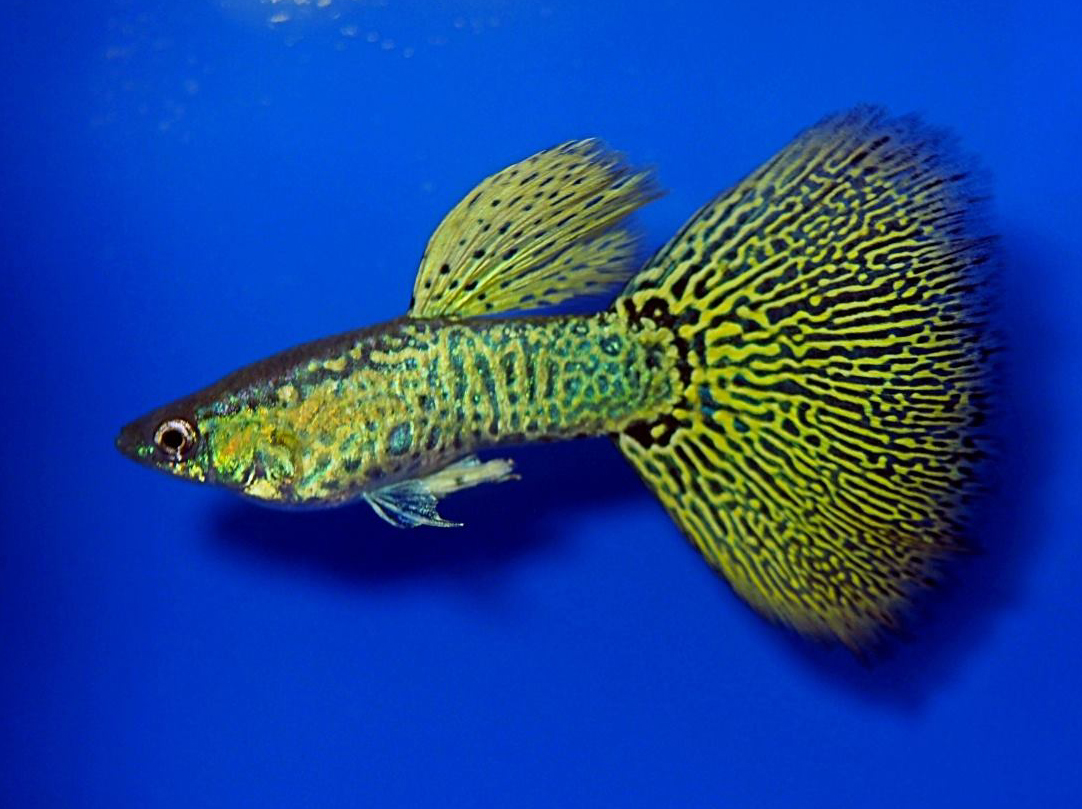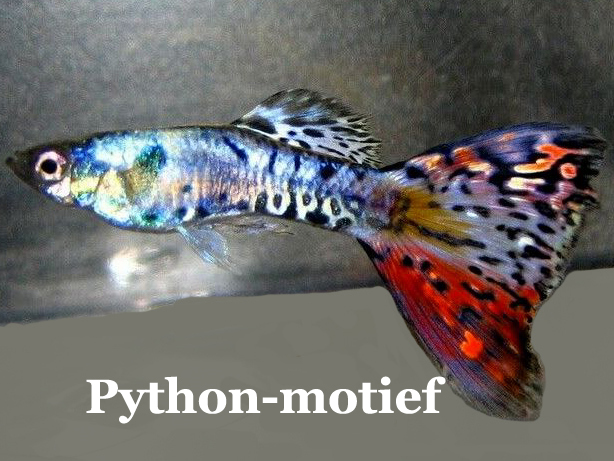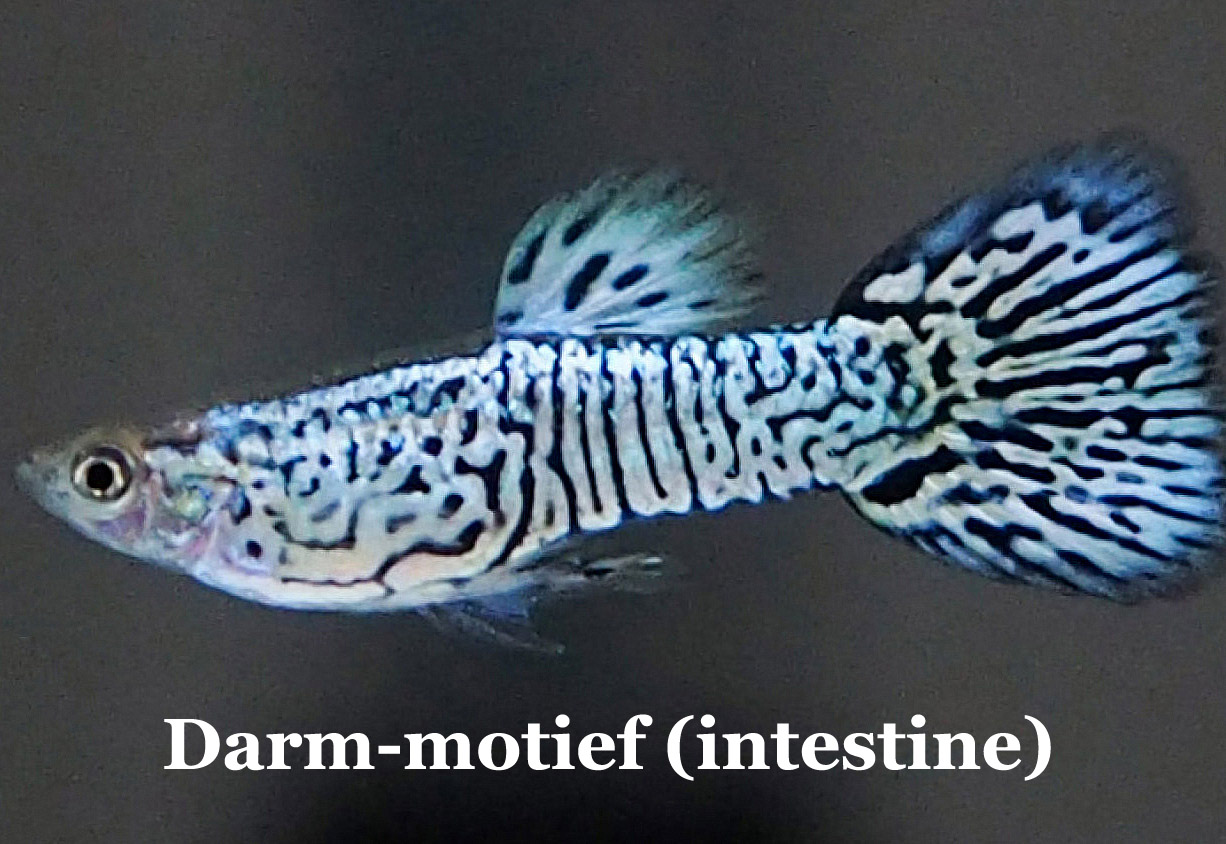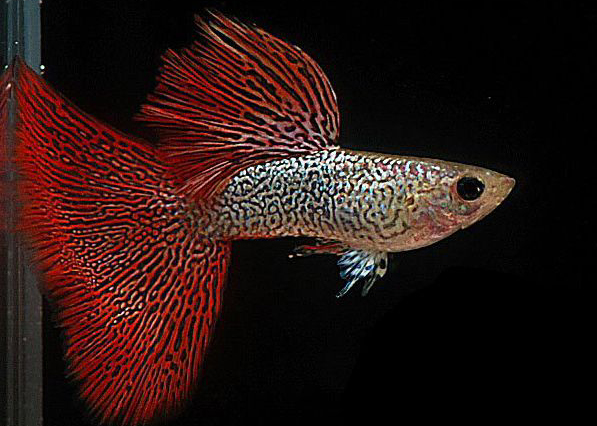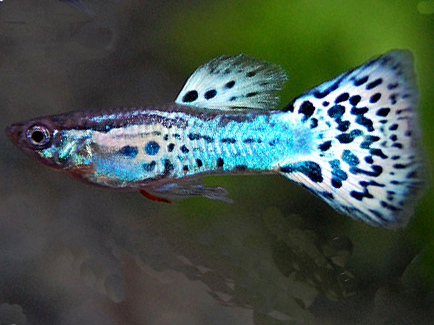Art XIX
Research and study of the Snakekin pattern
RUBRIEK: Guppy Kweek English Translation
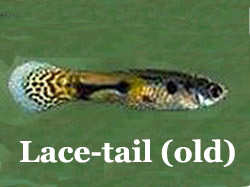
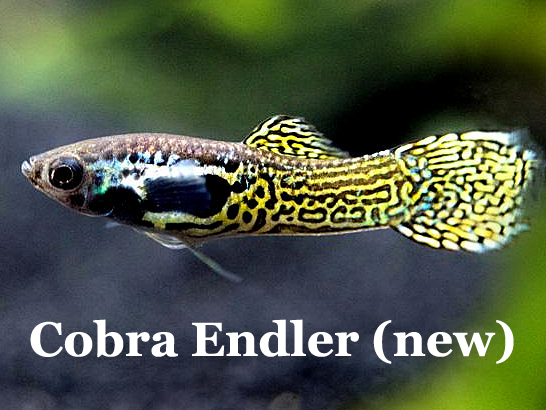

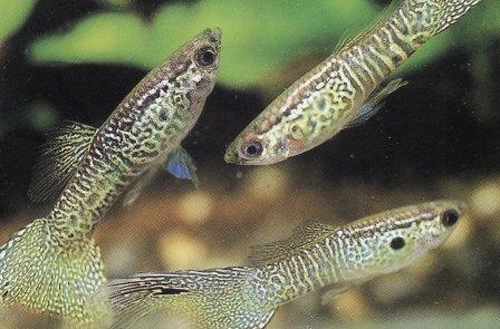
The first observations of this filigree drawing go back to the late 1950-s, where wild-caught guppies had the lace pattern on the tail fin (see photo at the top left). These guppies were rightly called the lace-tails . One can see these same lace-tails popping up in backcrosses such as the Ginga, or in crossings between Endlers and Guppies, such as the Cobra-Endler. And they can also be seen in regression due to inbreeding.
One had to wait until 1966 when a gup strain appeared with this drawing also on the body in an exhibition in Manchester. That interval of 16 years was necessary to breed the snakeskin drawing from a more chaotic pat-tern of stripes, spots and zigzags that already existed in the wild form. As is often the case in such matters, several breeders and authors tried to claim credit for this. But it often also applies in such cases that different persons in different countries (namely Germany, England and the USA) were si-multaneously working on the same breeding project. He was subsequently called Snakeskin .
In my youth one could find beautiful solid triangles in different or mixed colors, and double swords in the aquarium shops. The first novelty of those years, was the Snakeskin with its Snakeskin-drawing on its body and caudal fin. I was crossing with triangle tails in blue and green, but about this new strain with body markings and the color purple in the back of the body, I was excited, and got to work right away with them . Over the hard black flame pattern in the caudal fin, I chose the finer and more subtle lace drawing or filigree (see drawing opposite of one of my first breeding products).
For this new strain, the names Lace, Snakeskin, Cobra and King Cobra were randomly used interchangeably. Understandable, when one considers the richness of the pattern: the drawing on the body can vary from a network of serpentine lines that crisscross each other. But all kinds of figures can also be formed: stripes, chains, circles around a spot, up to and including real squares. Most of these drawings are oriented horizon-tally, but vertical stripes may also appear in the rear body, reminiscent of a zebra (all proportions taken into account) and therefore have been called Zebrinus (see opposite and Below).

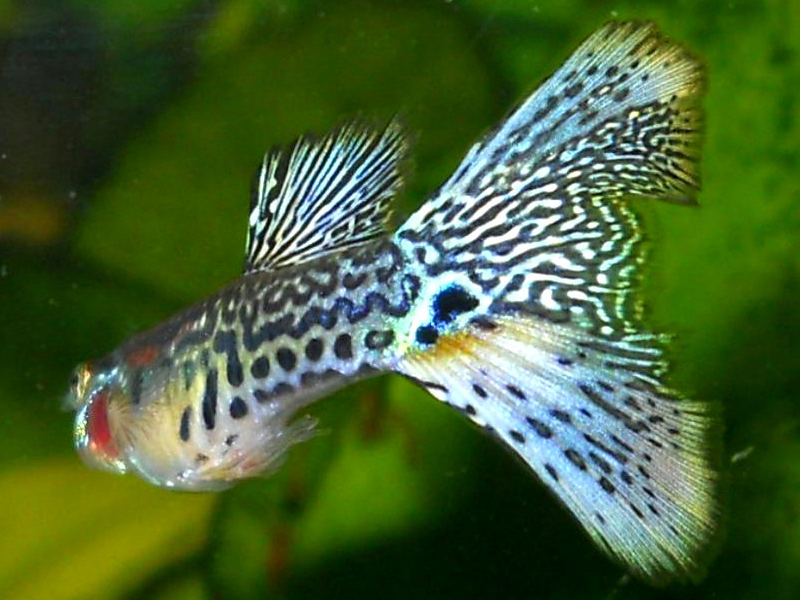

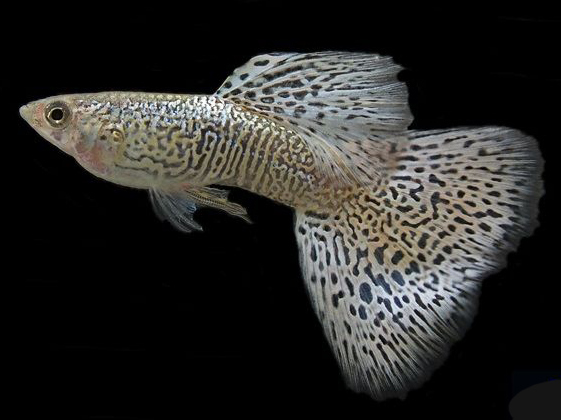
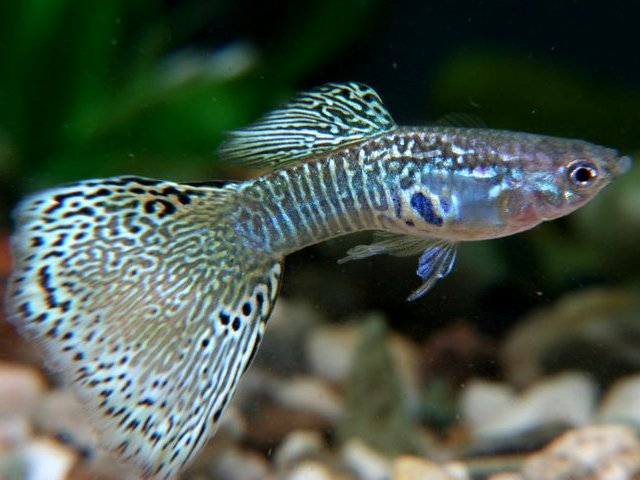

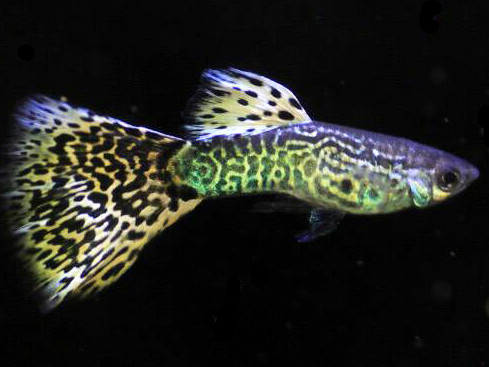
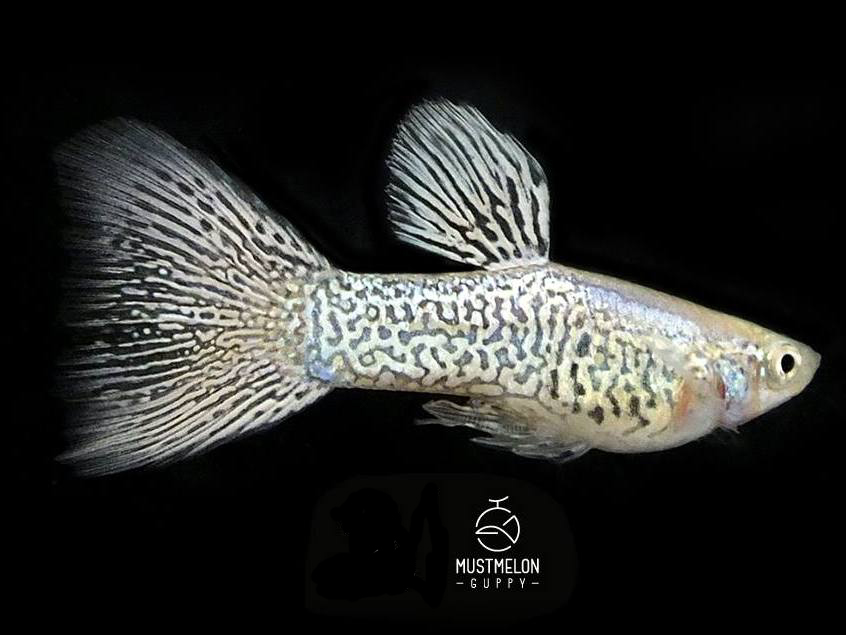
Should one start giving them all different names ? I don't think so, because the notion must dominate, that all those different drawings come from the same source: the Snakeskin pattern. But one can notice a connection be-tween the thickness of the drawing, and what else goes with it. The coarser and thicker the "squiggles" (see the first 2 examples on the right), the more spots also appear on the body, and the more the caudal fin drawing will tend towards mosaic instead of lace.
And the finer the network becomes, the finer the distribution on the tail fin will be. It could be argued that there are Snakeskins with a coarser Cobra drawing, and Snakeslins with a finer Lace drawing. If you look at the pattern of the latter in detail, you can see that the lacework of modern Snakeskins is more and more compacted into a very dense "weaving" of different "color threads" (see photo below left) .
All of this together ultimately shows how difficult it was to breed this completely new strain, and why it took so much time and patience. The Snakeskin gup is one of the few REAL and true renovation types that have been cultivated by growers all over the world over the decades. For the majority of the so-called "modern types" simply continue to permute gene pieces between existing types, or search for the most recessive characteris-tics to the farthest corners.
But the list of gup strains for which the Snakeskin has been used is impres-sively long: Ginga, Tiger (with Tuxedo), Dragon (with Tuxedo), Micariff, Galaxy, Nebula Steel, Crumble, Leopard, MetalHead, ... Due to the enormous stock of possibilities that the Snakeskin pattern offers, one can create an almost infinite number of new combinations from it, by empha-sizing other shapes or other colors. Although the Snakeskin initially came mainly in the colors, white, purple and yellow-green, today Snakeskins can be found in all colors of the rainbow.

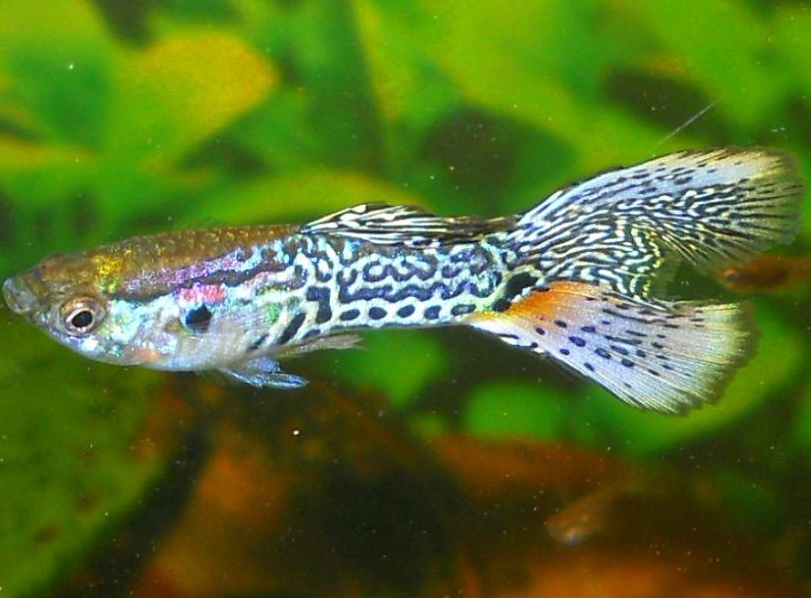

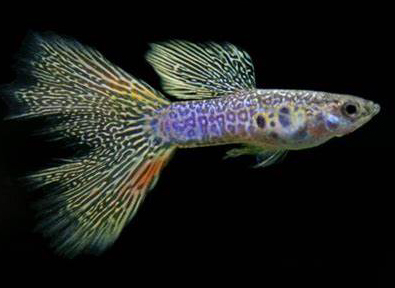

Therefore, it is recommended that one learn more about HOW exactly this Snake skin pattern is "made". As I have mentioned several times in my articles on gup genetics, that patterns are determined by the genes by location , and in two directions: horizontal and vertical . A black spot can therefore always be "drawn" in the 4 directions. I have shown this above on drawings above, to make this visually clear. Horizontally a spot is drawn to a line . Depending on the "hitches" or openings that are kept there, one gets other figures: twists, waves, points, chains, loops, ..... Compare this with the writing . Vertically the spot is drawn up to the zebra stripes or bars.
The blazck spots are also the result of such a "writing program": a spiral. Hence, at the beginning of breeding the Snake-skin strain, specimens with Bird-Eyes on their bodies were sough; not infrequently such a spot is surrounded with concentric lines as a result of this spiral formation. With regression -the decline of a cultivated strain to the wild-form- , or with backcrossing to wild-form (such as Endler), these same figures appear again as if by magic (see photo).
I humbly admit that I made a mistake at the time, in connection with the designation King Cobra. An error that became clear to me when I went through the (bitter) discussion between W. Storozew and Shaddock, and found that the King Cobra is a Snakeskin type of the first hour was, with two Cobra eyes on his side. And indeed, if we add the photo of a the Cobra or Naja, it becomes clear that when 2 such Bird-eye spots come to lie next to each other, one gets a figure analogous to the "glasses-drawing" of the Cobra. But it's extremely difficult to keep that as a permanent strain feature, because the chance of it occurring increases as the Snakeskin pattern is expanded to a coarse drawing. So it's no coincidence that it showed up in the begin period at the time of Snakeskin's creation, or at the end, when a strain begins to decline through regression. When the Snakeskin pattern is "written" in a more refined way, instead of large spots, more small spots appear (see photo on the left); and with further refinement, the intricate network of a snakeskin.
But strictly speaking the name King Cobra is not correct, unless for THIS specific pattern. Although the King Cobra is a snake, it cannot be used "as part for the whole": not every snake is a naja. In order to avoid naming chaos in the future, it is therefore recommended to use the term Snakeskin as general name. So that one can get to the picture below about the Snakeskin sub-types.
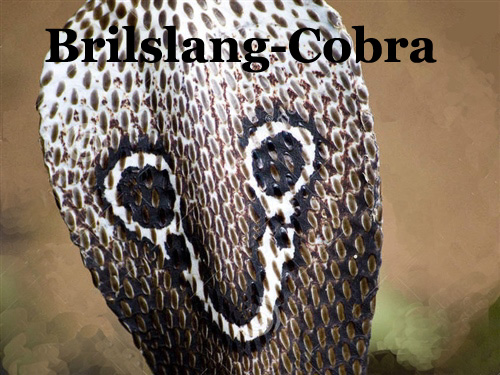
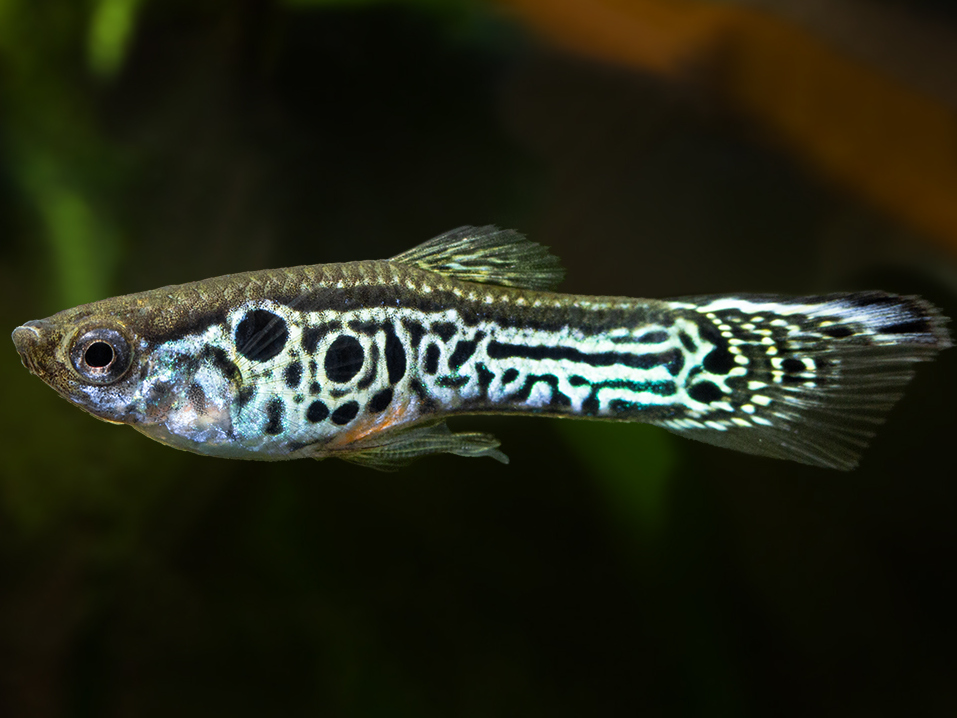

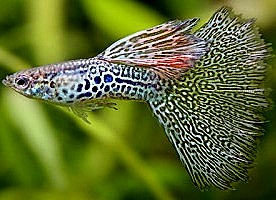
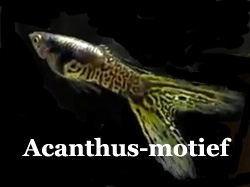

When looking for new figures, one must of course be careful not to let the overall pattern disintegrate. I have noticed that in Japan people dare to go very far, in crossing all kinds of strains. In this way new patterns can indeed be discovered, but in just as many cases this threatens the integrity of the strain. So it's a dime on its side. I'll come back to this later, but in the meantime just this: once a pattern starts to be broken, it becomes difficult to maintain it. "Dismantling" -or better: being solved- is easier than building up.
But let me first highlight the positive side: the new patterns that have emerged in this way. It starts with a center stripe that divides the rear body into two horizontal segments. That is something that pops up quite regularly (see photo). This creates a thrust upwards or downwards, both above and below that line. Each time forming quadrangular motifs. If you want to continue to breed this motif, you get what I have called the Acanthus motif , because it reminds me of the decorations on old Ionian columns, which were inspired by the acanthus plant.
Crossings with Galaxy regularly produce this new pattern. It has its specific charm, especially with guppies that have a variety of colors at the same time - the so-called Multis -: this motif creates a nice contrast between the dark of the lines and the bright colors of the bordered islands. The drawing itself looks more sober, clearer and less busy than -for exam-ple- many modern Lace, which are, as it were, overprinted. A described sheet must have a balance between writing and open space to be beautiful. Leaves that are written all the way into the corners, are experienced as "too": excess is harmful. Simplicity is beautiful.
When the middle part of the rear body is again cleared of drawings, one gets a motif that - to stay with snakes - reminds us of the drawing of a Python (see figure here next on the left). For this we have to look for crosses with Nebula Steel (see photo below).
The finer the Snakeskin pattern becomes, the busier the drawing becomes. Some Lace seem to consist of thousands of colorful dots, as if it were a painting with pointillism . The thicker the lines, the clearer the design becomes. Compare the photo of the Red Lace on the right, for example, with the simple drawing of the Cobra above: it seems as if a "intestine" is completely rolled up in his body. The purple-red Nebula Steel again above, looks more like an abstract painting. The question is therefore what kind of painting style is his personal preference.
One style is definitely out of the question: minimalism. Last in the left column is a Snakeskin of which the drawing has almost completely disappeared. When that is done, it is too late "to turn back the clock". The loss of a certain pattern with the associated genes that guarantee it, is an irreversible process. Hence the need among guppy breeders to cross back to wild caught every so often to replenish the gene pool. Or to exchange certain strains with each other, as "shortcuts" in order not to have to start the entire breeding route from scratch.
I wanted to close this article with the photo of a Snakeskin that I like very much. I thought this was going to be the easiest part of the whole article, but I was very mistaken. After all, there are so many photos of photogenic cobras, one more beautiful than the other. The fact that it eventually became a yellow-green Snakeskin is a bit of a tribute to the basic shape and collors, to which we owe all those nice variations.

